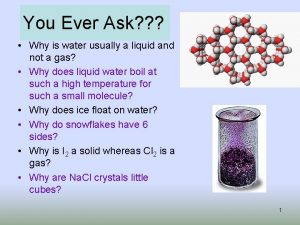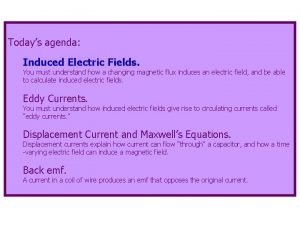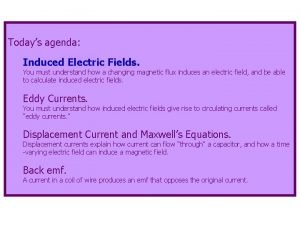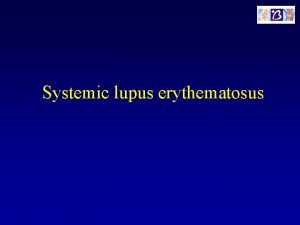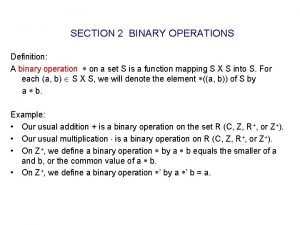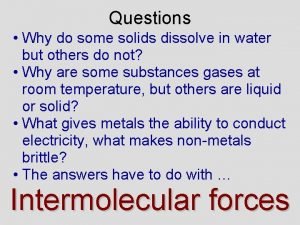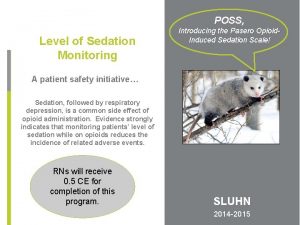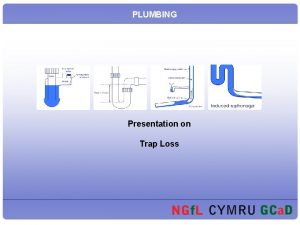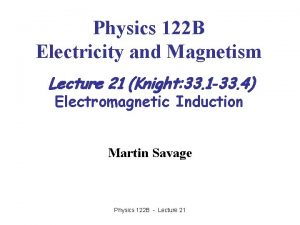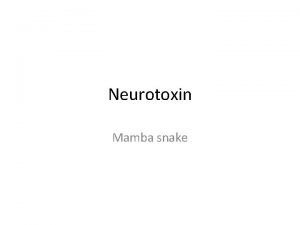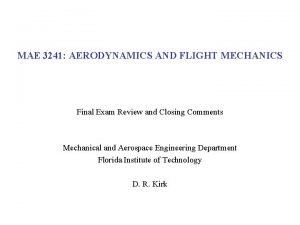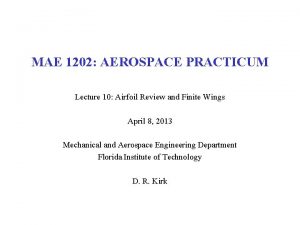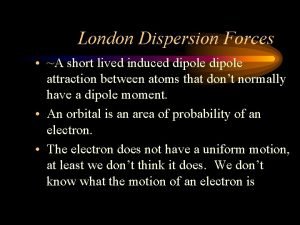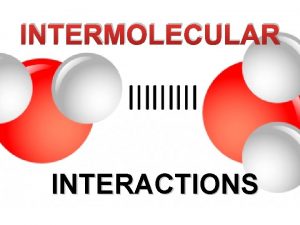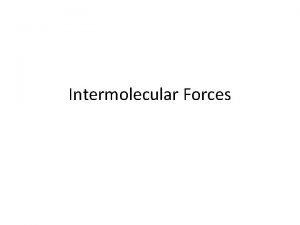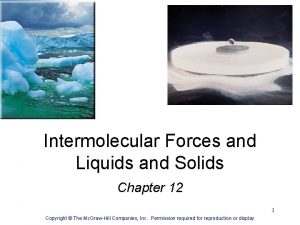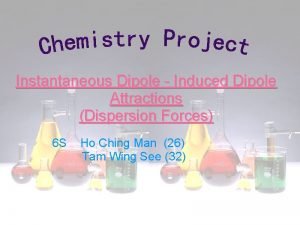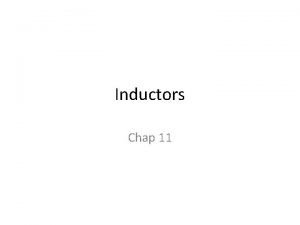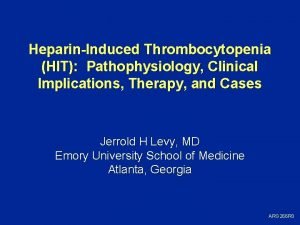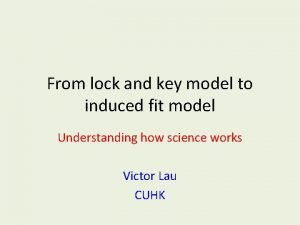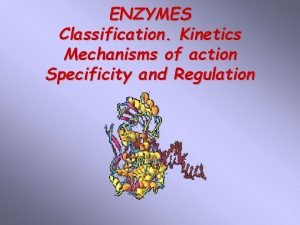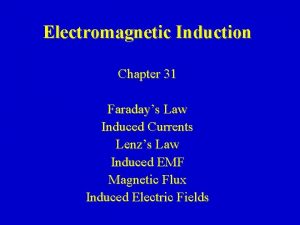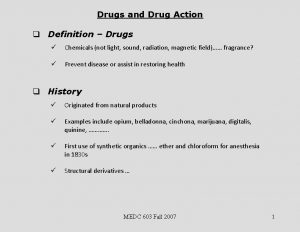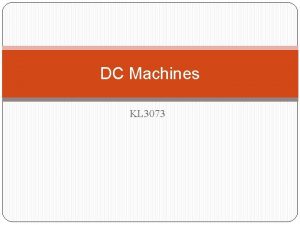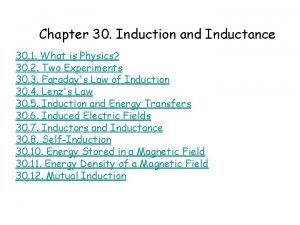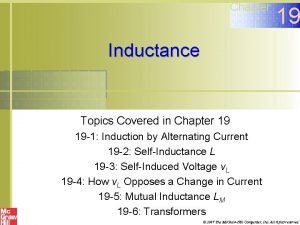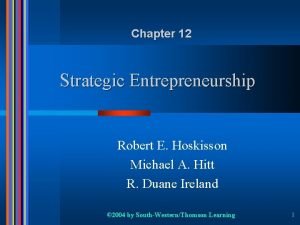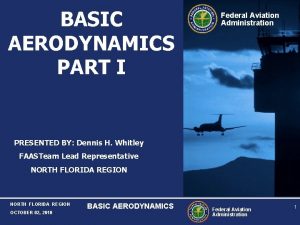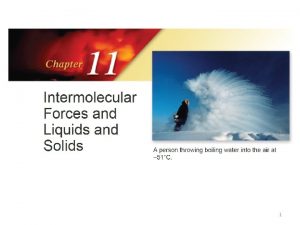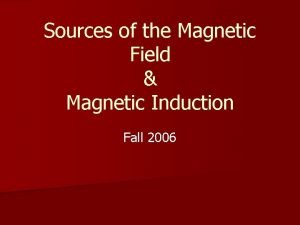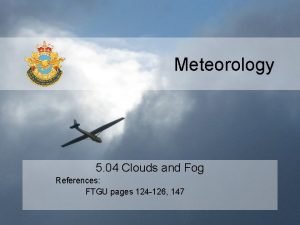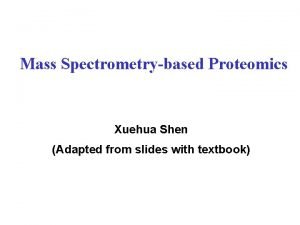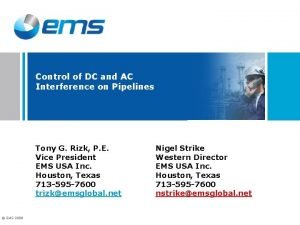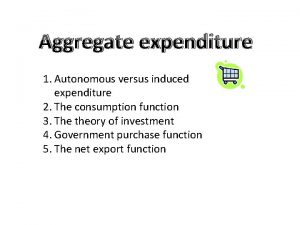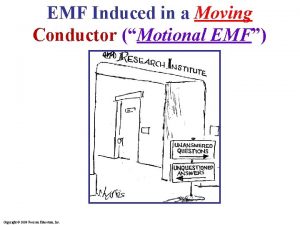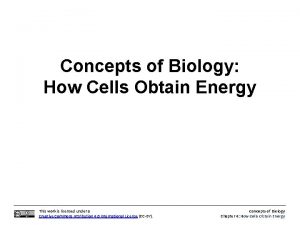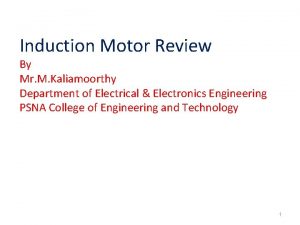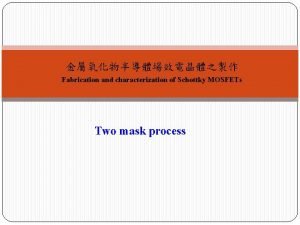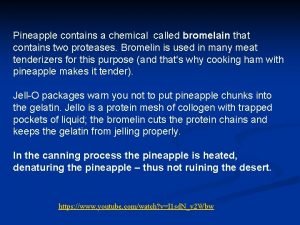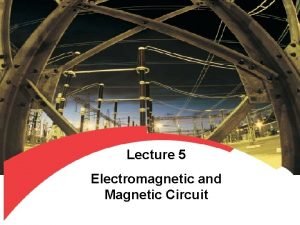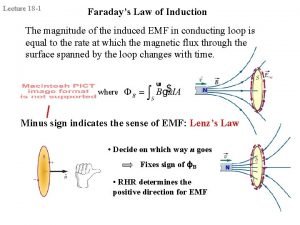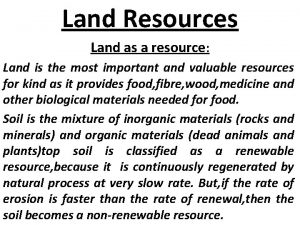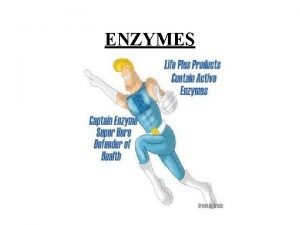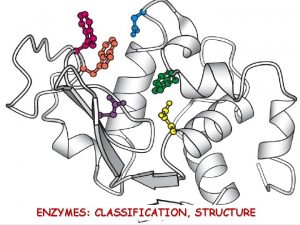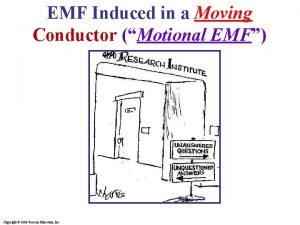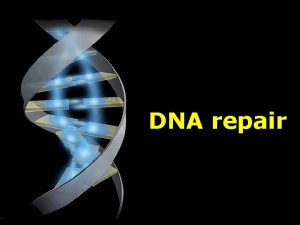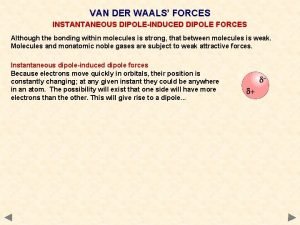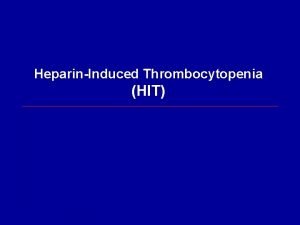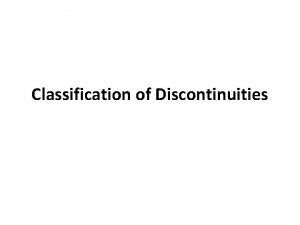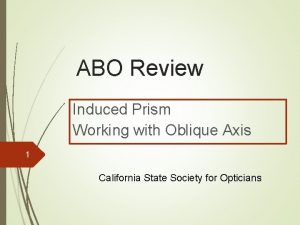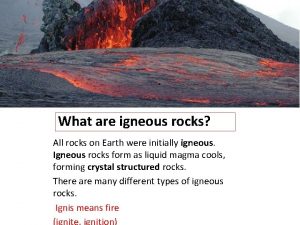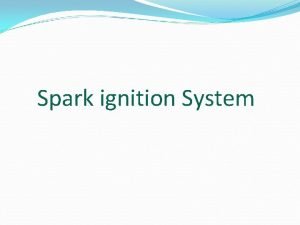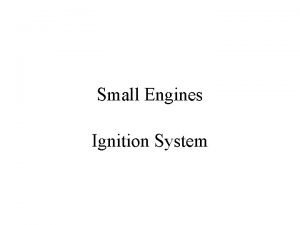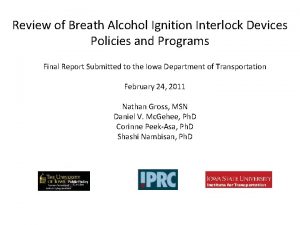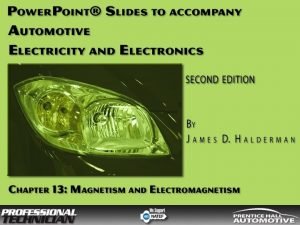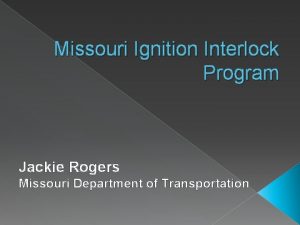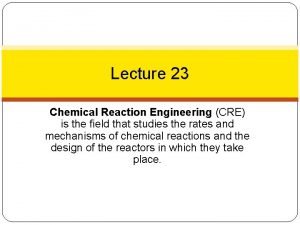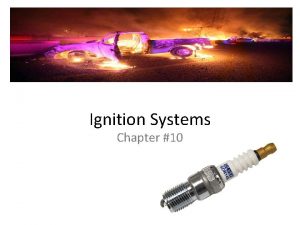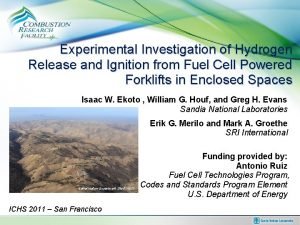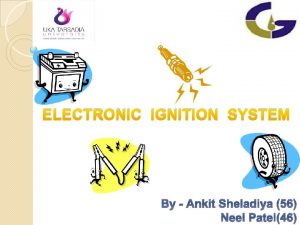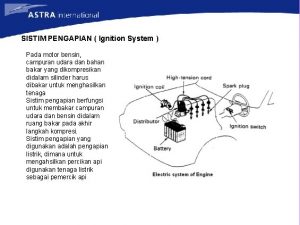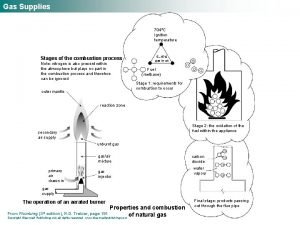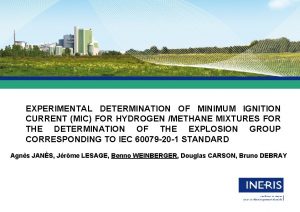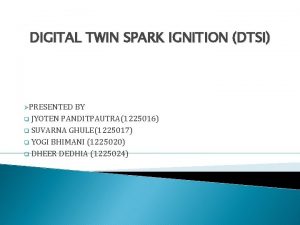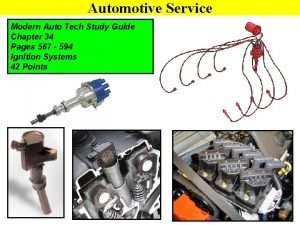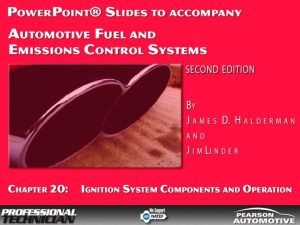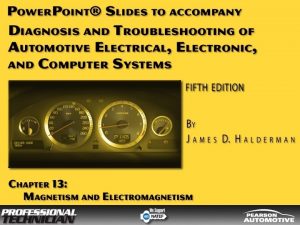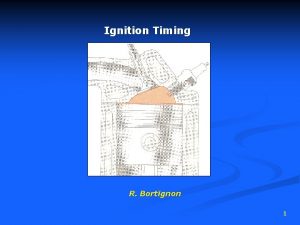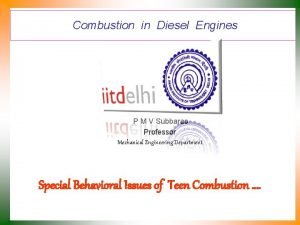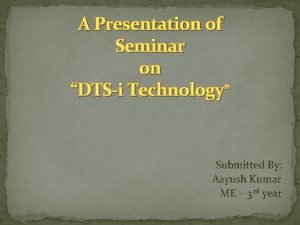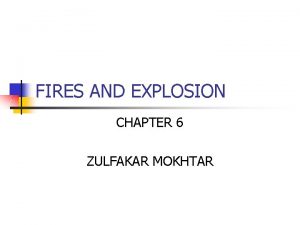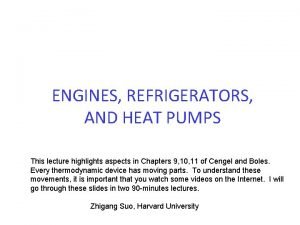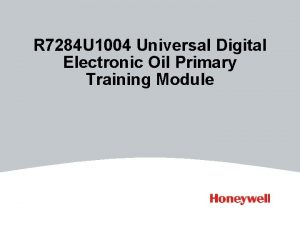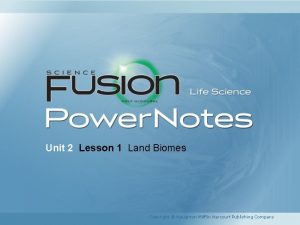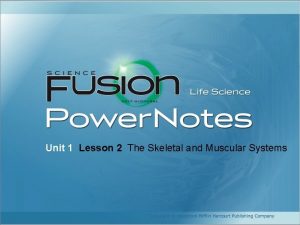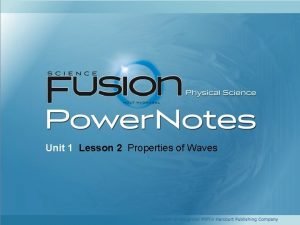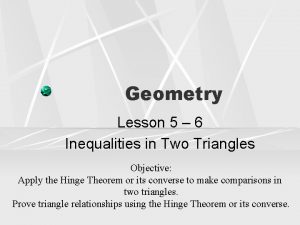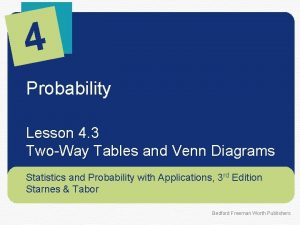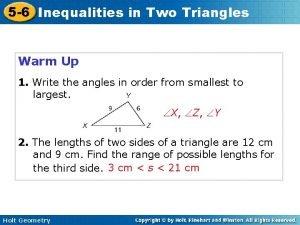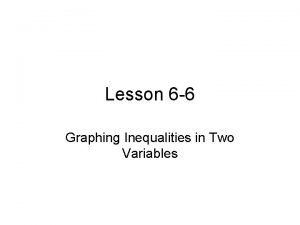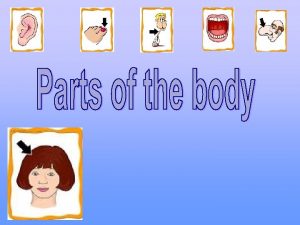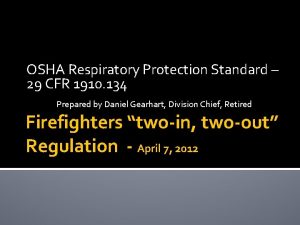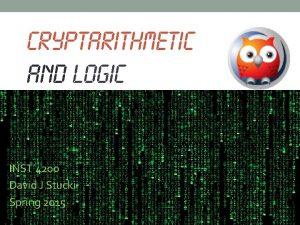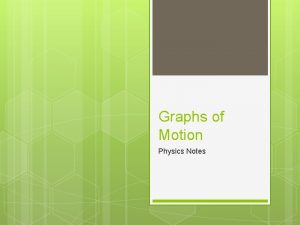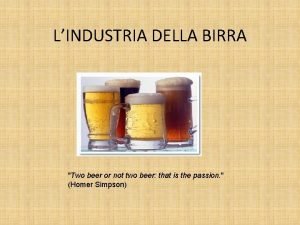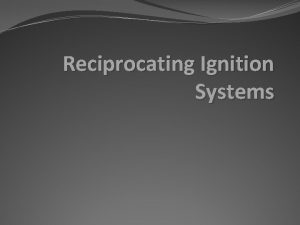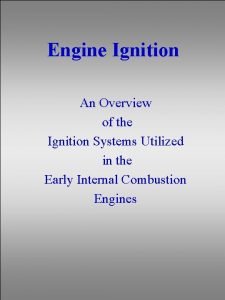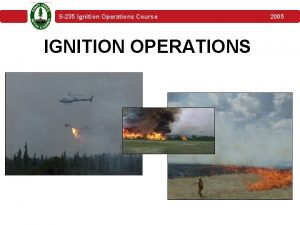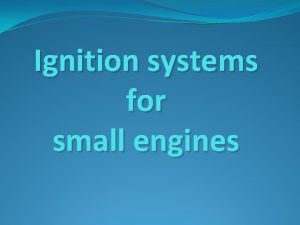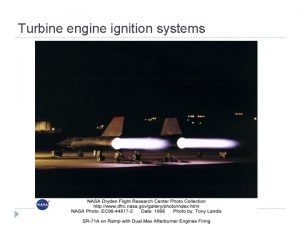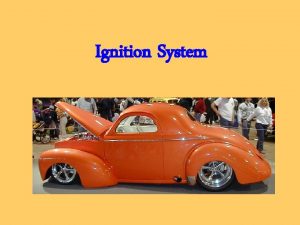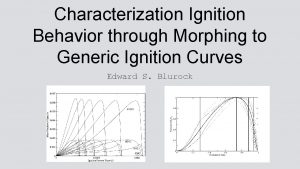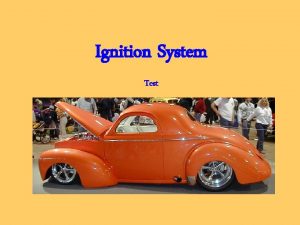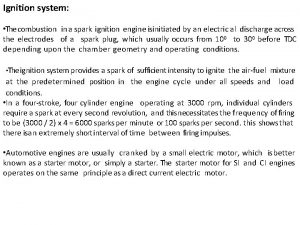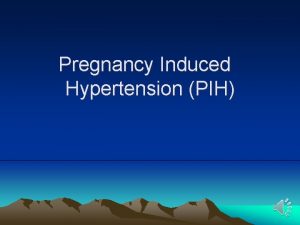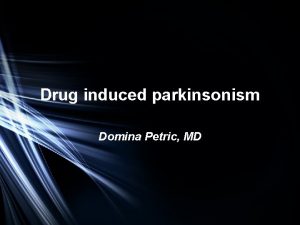Lesson 4 Ignition Two types of Ignition Induced





![Combustion Chemistry Changes Dramatically with T, [O 2], P • High T: R. H. Combustion Chemistry Changes Dramatically with T, [O 2], P • High T: R. H.](https://slidetodoc.com/presentation_image_h/bf2add25b90ac7681ea8107af4cae4ce/image-6.jpg)




























































































































































- Slides: 162

Lesson 4: Ignition

Two types of Ignition • Induced ignition is forced by a spark or laser pulse • Autoignition is spontaneous combustion: a fuel-air mixture initially at To ignites after a time delay Both types of ignition are important, but here we only discuss Autoignition. Diesels are designed to use Autoignition; usually in a Diesel engine you want to be short. Otto cycle engines (e. g. SI gasoline engines) use a spark to ignite the mixture. Usually in an Otto engine you want to be so large that the mixture never autoignites. Autoignition causes “knock”

Several different reasons to care about Low-T Combustion Chemistry • Spark-Ignited Engine power & efficiency strongly constrained by knock (i. e. unwanted autoignition). • Diesel ignition delay about 50% due to chemistry • So civilian Diesel fuel has a cetane spec • Many of the challenges in Military diesels are because JP-8 does not have a tight cetane spec, & has high fuel variability • “LTC” engine concepts very sensitive to fuel ignition, add a control element to adjust (e. g. duel fuel or EGR) • Provide large increase in efficiency at ~constant power density: huge potential value to society (and to military) • Viability of Alternative Fuels for civilian ground transport • Jet engines: We think ignition & re-light sensitive to LTC but note a spark is involved. Unwanted autoignition at high T 3. W. H. Green, MIT

Because it is so important, Combustion Chemistry in general, including Low-T Ignition, has been well-studied. Many reviews of low-T combustion chemistry, e. g. : • S. W. Benson, PECS (1981) • C. K. Westbrook, PECS (1984) & PECS (2000) • Walker & Morley, Comp. Chem. Kinet. (1997) • F. Battin-Leclerc, PECS (2008) • Zador, Taatjes, & Fernandes, PECS (2011) Community has achieved very detailed quantitative understanding of several simple fuels, with demonstrated accuracy for large number of observables. But still some aspects of these models are incomplete, and many of the numbers have significant uncertainties. This talk is just my perspective on what is important, not the full story by any means… W. H. Green, MIT

Ignition Delay (ms) Ignition Delays well-behaved if To is low or high, but strange “NTC” behavior if start with To in between. Less sensitive to fuel composition at high To (>950 K). Ignition delays sensitive to fuel composition if To is in “NTC” region Similar slopes if To is very low (~600 K) Ea ~ ½ Ea(ROO QOOH) + ½ Ea(OQOOH OH) See Merchant et al. Combust. Flame (2015) Most JP-8 fuels have similar (and short) High-T ignition delays 1000 K / Initial temperature To W. H. Green, MIT
![Combustion Chemistry Changes Dramatically with T O 2 P High T R H Combustion Chemistry Changes Dramatically with T, [O 2], P • High T: R. H.](https://slidetodoc.com/presentation_image_h/bf2add25b90ac7681ea8107af4cae4ce/image-6.jpg)
Combustion Chemistry Changes Dramatically with T, [O 2], P • High T: R. H. ; H. + O 2 . OH +. O. • Chemistry is very fast, often faster than mixing times • Unimolecular reactions of R. faster than R. +O 2 • Medium T (~NTC): R. +O 2 HO 2; H 2 O 2 cycles • R+O 2 = RO 2 equilibrium lies on left at medium T • H+O 2+M HO 2+M suppresses H+O 2 OH + O • Low T: R. + O 2 RO 2 ; HOOQO cycles • Very complicated sequence of reactions… W. H. Green, MIT

Usually fuel starts at low To and goes through all 3 stages of chemistry. In diesel and jet, f changing with T during mixing. Products from one stage are initial conditions for next. stage. Premixed Propane/Air, 10 bar f=1 To = 650 K At low T R+O 2 OQOOH then at higher T R+O 2 HO 2 then at highest T R H followed by H + O 2 OH + O W. H. Green, MIT

High T (>1000 K) ignition pretty well understood… • High T Ignition delays can be predicted quantitatively with detailed models. • Significant challenge is handling complexity of real fuels…but fortunately fuel decomposition nicely separates from the small-molecule chemistry (e. g. see work by Stanford team) • Main challenges at high T not ignition, but accurately modeling/predicting soot formation, & correctly handling chemistry-flow (turbulence) interactions. W. H. Green, MIT

Chemical Amplification • Ignition chemistry is primarily about chemical amplification: how fast can the number of active radicals e. g. [OH] grow? • A lot of growth happens before the fuel is significantly consumed, T is increasing slowly. • At least initially, this process is pseudo-linear, can be characterized by a positive eigenvalue l: [radicals] = [radicals]0 exp (lt) • Helpful to analyze the chemistry this way: look for positive eigenvalues of Jacobian and the corresponding positive feedback loops in the chemistry. W. H. Green, MIT

Medium T: The HO 2/H 2 O 2 Amplifier (for fuels that make HO 2, e. g. alcohols; alkanes at high T) 2 OH 2 R H 2 O 2 2 RO 2 HO 2 Chemistry is Slow and Self-Limiting by HO 2 + HO 2 But it generates Heat. +RH Self-reaction 2 HO 2 l ~ sqrt(2*kdecomp*k. HO 2+RH[RH]) during exponential stage W. H. Green, MIT HO 2 + HO 2 = H 2 O 2 + O 2 is neutral HO 2 + RH = R + H 2 O 2 is chain branching 10

Medium T (~750 -1000 K) ignition chemistry is understood moderately well. Sensitive to fuel, T(t), f(t), P(t), heat losses. • We think we know most/all the important reactions. • HO 2 reacts in several ways, some rates not conclusively nailed down, e. g. • HO 2 + R RH + O 2 versus HO 2 + R RO + OH • Sensitive to HO 2 + RH but OH + RH is main fuel consumer • Ignition delays sensitive to transitions from low-T to medium-T, and medium-T to high-T mechanisms; carryover of reactive species formed by the earlier chemistry. T(t), [RH], [O 2], P(t) all matter. • Significant low-T chemistry occurs as fuel is raised to reaction temperature (e. g. in RCM or flow tube). • hard to know what discrepancies between model and experiment are due to medium-T vs. low-T chemistry. W. H. Green, MIT

The (complicated) low-T (500 K – 750 K) radicalgenerating cycle is (pretty well) understood • The basic idea of this cycle was understood long ago… • …but not the details, e. g. 4 of the reactions on this chart were unknown 20 years ago, and 3 were discovered in the last 5 years. • Only a limited range of RH’s have been considered, maybe some more chemistry waiting to be discovered. • Rates, thermo mostly known from quantum calculations. • Important experiments by Sandia group, Walker, Adapted from Zador, Taatjes & Fernandes H 2 O + keto-oxyl Battin-Leclerc, etc. W. H. Green, MIT

Low-T and Medium-T Radical-Generating Cycles are coupled. Sensitive to 5 key branch-points in the chemistry. W. H. Green, MIT

Low T (500 K – 750 K) ignition delay very important in internal combustion engines (main measure of fuel quality is cetane number or octane number) • Low-T chemistry provides the fast growth from nearzero radicals to significant radical concentrations • much faster than the medium-T H 2 O 2 cycle • amplifies radical concentration by 5 orders of magnitude, sets initial condition for medium-T • Self-limiting because oxidation raises T until this cycle turns off (R+O 2 mostly makes HO 2). W. H. Green, MIT

Low T ignition not as well understood as high and medium T chemistry • Empirical approaches e. g. “blending octane” and “IQT derived cetane number” have limited applicability • Only for specific tested conditions • Limited ability to predict effect of changing fuel blend. • Many distinct reactive intermediates. Still discovering that additional reactions and species are important, at least in some cases. • Peroxy chemistry challenging for both experimentalists and quantum chemists, so rate and thermo parameters not as well known as for hydrocarbon chemistry. W. H. Green, MIT

Some fuels show two-stage Ignition (if you start with a low To)

Computed “Two-stage” ignition of Propane, To=650 K, Po = 10 bar Experimentalists can sometime Discern the point of inflection In T(t) before the “hot” ignition

Good news: Low-T is not quite as bad as one might fear • Clear stages dominated by different physics • Natural simplifications • One stage usually controls the ignition delay • Only a few reactive intermediates matter • Drastically reduces number of rate coefficients required • Fuel ignition characterized by just a few parameters W. H. Green, MIT 18

Several stages evident in speciesprofiles

At Low temperatures Peroxy Chemistry Controls Radical Formation

The Low-T “QOOH” Amplifier g S. S. Merchant et al. , Combust. Flame (submitted) • Reactive Intermediate Concentrations rapidly rise ~10 orders of magnitude: chemical amplifiers • Amplifier Gain: 1 OH in, 3 abg OH’s out • If abg=1, l ~ sqrt(2 kdecompk. ROO=QOOH) W. H. Green, MIT 21

Of course, Full system Is complicated

Stages of Ignition Stage 2 • Some fuels show two stages of ignition by a kink in T(t) • In reality, all fuels also have an early exponential growth stage (“ 1 A” in figure), where all concentrations increase as exp(l ) • “Knee” between Stage 1 A and 1 B when HO 2+HO 2 becomes significant (relative to HO 2 + fuel) W. H. Green, MIT 23

If there is an explosive eigenmode, it is the only thing that matters… • Time until HO 2+HO 2 competes, i. e. until end of stage 1 A, only depends on 10 rate coefficients (out of several hundred reactions in propane mechanism): W. H. Green, MIT 24

HO 2 important in Stage 1 A, but much less important in Stage 1 B

During Stage 1 B, amplifier is damped by increasing losses to HO 2 + HO 2 • QOOH amplifier Gain 3 abg drops as T increases, • until Gain = 1 at some Tmax. • Mostly due to RO 2 HO 2 + alkene vs. RO 2 = QOOH • Gain<1 causes drop in [OH] and so reduced heat release rate. • Causes Point of inflection in T(t) (i. e. end of Stage 1 ignition) Only need ~10 rate coefficients to predict stage 1 ignition delays W. H. Green, MIT 26

From Eigenvalue analysis, can derive simple formulas for 1

Small T rise matters a lot! Here we assume perfectly adiabatic. Ignition delay sensitive to heat losses, and to rates of reactions which release heat, such as OH + CH 2 O

Simple formula accurately predicts Stage-1 ignition delays for n-alkanes • Figure shows detailed ~1000 reaction model predictions (solid) vs. the simple algebraic formula (dashed) 10 bar, f=1 in air, adiabatic W. H. Green, MIT 29

Low T ignition formula was based on analysis of QOOH amplifier. What about fuels which cannot make QOOH? • Small hydrocarbons (methane, C 2’s) • Aromatics (with no long side chains) • Small alcohols • …for example, Methanol CH 3 OH • Note: alcohols make a lot of HO 2 via HOR. + O 2 HO 2 + carbonyl, so we analyzed the H 2 O 2 amplifier W. H. Green, MIT 30

The H 2 O 2 Amplifier (for fuels that make HO 2, e. g. alcohols; alkanes at high T) 2 OH 2 R H 2 O 2 2 RO 2 2 HO 2 l ~ sqrt(2*kdecomp*k. HO 2+RH[RH]) during exponential stage W. H. Green, MIT HO 2 + HO 2 = H 2 O 2 + O 2 is neutral HO 2 + RH = R + H 2 O 2 is chain branching 31

H 2 O 2 amplifier less effective than QOOH amplifier…but methanol at 800 K is very similar to propane at 750 K CH 3 OH, 800 K Propane 750 K HO 2+HO 2 controlled phase Exponential phase W. H. Green, MIT 32

Simple analytical formulas based on structure of H 2 O 2 amplifier and a few rate coefficients accurately match complete numerical solution in both stages of pre-ignition. In quasi-steady-state due to HO 2+HO 2 Exponential Rise in HO 2 (and other species) Qualitatively the same as alkanes: Alcohols also show a “knee” due to onset of HO 2 + HO 2 W. H. Green, MIT 33

We can predict high-T ignition delays. We can predict low T ignition delays (at least for alkanes). Can we predict intermediate T as well? Next step: analyze the coupled QOOH and H 2 O 2 amplifier system operating in NTC region Complicated, but only Tens of Important rates, not Thousands. W. H. Green, MIT 34

How to model complicated Low-T chemistry? Often too many QOOH etc species to measure each one experimentally. Here are two alternative approaches: 1) Calculate all the QOOH etc isomers from first principles using tools like KINBOT and RMG. - Accuracy of first-principles approach has been demonstrated. - Detailed model, predicts all observables. - Need model reduction for CFD. - Will require supercomputers, cost increases with size of molecules. 2) Find a way to lump QOOH’s etc. together. Calibrate lumped model with experiments. - Won’t be able to predict as many observables as detailed model. Accuracy not yet demonstrated in a convincing way Might work even if fuel composition not perfectly known. W. H. Green, MIT

The complexity is real • If you want to predict all the chemistry details, the model has to be detailed (i. e. very complicated) • There is an ongoing long-term project to be able to predict fuel chemistry in detail • So far good success with a simple light fuels (e. g. methane, heptane, butanols). Good prospect for predicting all of gasoline chemistry in detail by 2025. • Full-detail chemistry scales poorly with molecular size: • difficult-to-completely-impractical for jet fuel • not at all promising for diesel or heavier fuels. If we really need to know every detail about our fuels and their chemistry, things are not looking good… W. H. Green, MIT 36

Fortunately, not everything is Important • Only need to measure or compute the important species and rate coefficients • At high T, fuel decomposition simplifies things quite a lot! • e. g. we can predict JP-10 decomposition above 1100 K even with O 2 present, based on quantum chemistry calculations C. W. Gao et al. , Combust. Flame (2015) But Low-T Ignition seems more challenging: so many species and poorly known k(T)’s W. H. Green, MIT 37

We can predict ignition delays using full-detailed models… but it is challenging. Isobutanol ignition delay predicted from first principles down to 800 K W. H. Green, MIT

For a real fuel, large set of distinct ROO, QOOH, etc. How to Lump? What matters most: When OH and HO 2 go into the box, how much peroxide, OH, and HO 2 comes out? This could be measured. Or just measure l. W. H. Green, MIT W. H. MIT 39

For example, measure OH vs time (e. g. in shock tube) to obtain l(T, [O 2]) W. H. Green, MIT

Summary • Focusing on the important physics in each stage drastically simplifies low-T chemistry • Simple analytical formula from eigenvalue analysis accurately predicts QOOH-controlled first-stage ignition delay for the n-alkanes • This is approximately equal to total ignition delay below NTC region • From the two easy-to-compute high-T and low-T curves of ignition delay vs. T one might be able to estimate ignition delay in NTC region • Similar analysis also works for systems where H 2 O 2 amplifier is controlling ignition (e. g. small alcohols). • Ignition controlled by tens, not hundreds or thousands of rate coefficients! • How best to determine those tens of rate coefficients? How to optimally combine theory and experiment? W. H. Green, MIT 41

Future Directions • Do similar analysis to cover stage 2 and NTC region, and other fuel types (e. g. aromatics, methane). • Write a simple, accurate, fundamentally-based expression for ignition delay at any condition! • Complete analysis for any fuel of known composition (e. g. surrogates) looks practical. • The important parameters can come from quantum chemistry and/or experiment. • Models likely to be simple enough to be included in CFD • but the implementation requires some thought. • Perhaps there is a way to measure the key fuel parameters (e. g. the Tdependent Gain 3 abg) directly even if one does not know the fuel composition? • This would be more fundamental than cetane & octane numbers, and might be easier and more accurate than doing the difficult analytical chemistry to determine the fuel composition. W. H. Green, MIT 42

Acknowledgments • Shamel Merchant, C. Franklin Goldsmith, Michael Burke, and Stephen Klippenstein collaborated in the QOOH amplifier analysis for alkanes. • Nathan Yee, Mark Goldman, Shamel Merchant, Samah Mohammed and Mani Sarathy collaborated in aspects of the alcohol/H 2 O 2 amplifier analysis. • Several others have made advances in this line of research previously (and ongoing), notably Norbert Peters and his collaborators. Recently Tianfeng Lu and Ed Law have emphasized eigenvalue analysis for explosive modes. W. H. Green, MIT 43

Kinetic Modeling of Autoignition: Engine Knock, HCCI and fuel economy Charles K. Westbrook Lawrence Livermore National Laboratory CEFRC June 2010

The fuel situation in 1922 looks pretty familiar • Thomas Midgley, Chief of Fuels Section for General Motors, 1922 – US Geological Survey -- 20 years left of petroleum reserves – Production of 5 billion gallons of fuel in 1921 • Potential new sources of petroleum – Oil shale – Oils from coal – Alcohol fuels from biomass • Higher efficiency a high priority for conservation reasons – – – People will not buy a car “lacking in acceleration and hill climbing” Solution is higher compression ratio, then at about 4. 25 : 1 Obstacle is engine knock, whose origin is unknown Result was development of TEL as antiknock Phenomenological picture with no fundamental understanding

Explanation of engine knock, ON, antiknocks, diesel ignition, and HCCI ignition came in the 1990’s from DOE/BES theoretical chemistry and supercomputing and EERE knock working group Alkylperoxy radical isomerization rates are different in paraffin and cyclic paraffin hydrocarbons Low temperature chain branching paths Most work has been done for alkane fuels, and many questions remain for aromatics, cyclic paraffins, large olefins

Chemistry of alkylperoxy radical isomerization has reached street-level awareness • Heat release rates in HCCI combustion of two fuels, iso-octane with no low T heat release, and PRF-80 with two stage heat release • We are seeing researchers debating which makes the better HCCI fuel. Both debaters have completely accepted the existence and source of the low T reactivity. Low temperature heat release Results from experiments of Sjöberg and Dec, SNL 2006 This is serious, black-belt fuel chemistry and computational chemistry

New conceptual picture developed 1990 - 1997 • Extended role of multiple advanced laser diagnostic techniques • Team led by John Dec, SNL • Explains – 2 stages in diesel burning – ignition and cetane – sooting logic • This is serious, black-belt optical physics science Lots still unknown, soot chemistry, spray dynamics fuel effects, etc.

Homogeneous Charge Compression Ignition (HCCI) engine delivers high efficiency, and low particulate and NOx emissions: Advantages: low NOx low particulate matter high efficiency Technical challenges: engine control multi-cylinder balancing startability low power output high HC and CO emissions

Have we have come a long way since 1922? • We still are looking to oil shale, oil sands and biomass for the future • However, our understanding of knocking, antiknocks and low T chemistry has grown enormously e. g. , Current engine designers debate how much low T heat release is best, and take its sources for granted • Conceptual model for diesel combustion has led to breakthroughs e. g. , Understanding of anti-sooting action of oxygenates • Entirely new concept engine (HCCI) is being developed Great majority of this progress is due to basic science understanding, e. g. , optical diagnostics, quantum chemistry and electronic structure theory, high performance computing, etc. We have used basic science advances to make big jumps in understanding, but we are back to trial and error in many cases

Octane numbers of heptanes are due exclusively to their different molecular structures This was recognized in 1920’s but no explanation in fundamental terms had been provided prior to our work

Engine knock is an undesirable thermal ignition

We focus on three distinct chain branching pathways 1) H + O 2 O + OH High T 2) H + O 2 + M HO 2 + M RH + HO 2 R + H 2 O 2 Medium T H 2 O 2 + M OH + M 3) R + O 2 RO 2 Low T RO 2 QOOH O 2 QOOH 3+ radicals

n-hexane ignition 1, 600 1, 400 Temperature 1, 200 1, 000 800 600 400 200 0 0. 00 E+00 2. 00 E-01 4. 00 E-01 6. 00 E-01 8. 00 E-01 1. 00 E+00 1. 20 E+00 Time Heat release rate Temperature

Chain branching at high temperatures H + O 2 O + OH • Activation energy is relatively high (16. 8 kcal/mol) • H atoms produced by thermal decomposition of radicals e. g. C 2 H 5 , C 2 H 3 , HCO, i. C 3 H 7 , etc. Activation energies relatively high ( ~ 30 kcal/mol) • Therefore this sequence requires high temperatures • Illustrated best by shock tube experiments

Chain branching often occurs over a series of reactions H + O 2 + M HO 2 + M RH + HO 2 R + H 2 O 2 + M OH + M • At temperatures below about 900 K, H 2 O 2 decomposition is inhibited, leading to degenerate chain branching • At higher temperatures, H 2 O 2 decomposes as quickly as it is formed, leading to conventional chain branching • Other low temperature chain branching paths can be much longer than this sequence (see below)

H 2 O 2 decomposes at a fairly distinct temperature • Reaction consuming H 2 O 2 is: H 2 O 2 + M OH + M k+ = 1. 2 x 1017 x exp(-45500/RT) • Resulting differential equation is: d [ H 2 O 2 ] = -[ H 2 O 2 ] [ M ] k+ dt

Characteristic time for H 2 O 2 decomposition d [ H 2 O 2 ] = -[ H 2 O 2 ] [ M ] k+ dt define = [ H 2 O 2 ] / (d [ H 2 O 2 ]/dt) = 1 / ( k+ [M]) = 8. 3 x 10 -18 x exp(22750/T) x [M]-1 At RCM conditions, with [M] ~ 1 x 10 -4 mol-cm-3, values of are approximately: 7. 8 ms at 900 K 640 s at 1000 K 80 s at 1100 K At higher compressions (pressures), values of are smaller at comparable temperatures

Rapid compression machine and some turbulent flow reactor experiments are controlled by H 2 O 2 decomposition • Rapid compression machine (RCM) usually operates in a degenerate branching mode - H 2 O 2 produced at temperatures lower than 900 K - When system reaches H 2 O 2 decomposition temperature, ignition is observed • Many turbulent flow reactor experiments operate at temperatures between 900 - 1100 K where H 2 O 2 decomposes as quickly as it is produced

Pentane isomers ignite in order of their octane numbers (RON 85) (RON 62) Ribaucour et al. , 2000 (RON 92)

n-Pentane (RON 62) and PRF 60 show different behavior in rapid compression machine (Cox et al. , 26 th Comb. Symp. , 1996) PRF 60 n-Pentane (RON 62)

Role of H 2 O 2 decomposition is very general • RCM ignition • Engine knock • HCCI ignition • Diesel ignition • Each system follows a unique pathway in the relevant phase space to arrive at this ignition temperature where H 2 O 2 decomposes

Kinetic features of engine knock • History of octane numbers and empirical observations • End gas self-ignition prior to flame arrival • Actual ignition driven by H 2 O 2 decomposition at ~ 900 K • Kinetic influence of molecular size and structure • Effects of additives, both promoters and inhibitors • Reduced models must retain H 2 O 2 decomposition reaction to describe ignition • Issue of real SI engine fuel being complex mixture of components • Lots of kinetics research still needed (aromatics, cyclics, etc. )

Detailed Chemical Includes high and low Kinetics for Components temperature ignition chemistry: Important for predicting low temperature combustion regimes 64

High Temperature Mechanism Reaction Class 1: Unimolecular fuel decomposition Reaction Class 2: H-atom abstractions Reaction Class 3: Alkyl radical decomposition Reaction Class 4: Alkyl radical + O 2 = olefin + HO 2 Reaction Class 5: Alkyl radical isomerization Reaction Class 6: H atom abstraction from olefins Reaction Class 7: Addition of radical species to olefins Reaction Class 8: Alkenyl radical decomposition Reaction Class 9: Olefin decomposition 65

Class 1 – Unimolecular fuel decomposition H H H HC–C–C–CH H H HC–C–C–C • H H H • C–CH H H Products are two alkyl radicals p. C 4 H 9 and C 2 H 5

Class 2 – H atom abstractions H H H HC–C–C–CH H H H H • H HC–C–C–C-C–CH H H H + OH Rate depends on the abstracting radical and on the site where the H is located (more later)

Two major keys to low temperature reactions BE (primary) > BE (secondary) > BE (tertiary) 68 68

Class 3 – radical decomposition H H • H HC–C–C–C-C–CH H H H Decomposition reaction based on beta-scission or “one bond away”

Class 3 – radical decomposition H H • H HC–C–C–C-C–CH H H H Decomposition reaction based on beta-scission or “one bond away”

Class 3 – radical decomposition H H • H HC–C–C–C-C–CH H HC–C–C=C H H H • C–CH H H 1 C 4 H 8 + + C 2 H 5 one stable olefin and one radical

Class 5: Alkyl radical isomerization H H • H HC–C–C–C-C–CH H H H

Class 5: Alkyl radical isomerization H H • H HC–C–C–C-C–CH H H H

Class 5: Alkyl radical isomerization H H • H HC–C–C–C-C–CH H H H

Class 5: Alkyl radical isomerization H H • H HC–C–C–C-C–CH H H H n. C 3 H 7 + C 3 H 6

Low Temperature (High Pressure) Mechanism Reaction Class 10: Reaction Class 11: Reaction Class 12: Reaction Class 13: Reaction Class 14: Reaction Class 15: Reaction Class 16: Reaction Class 17: Reaction Class 18: Reaction Class 19: Reaction Class 20: Reaction Class 21: Reaction Class 22: Reaction Class 23: Reaction Class 24: Reaction Class 25: Alkyl radical addition to O 2 R + R’O 2 = RO + R’O Alkylperoxy radical isomerization RO 2 + HO 2 = ROOH + O 2 RO 2 + H 2 O 2 = ROOH + HO 2 RO 2 + CH 3 O 2 = RO + CH 3 O + O 2 RO 2 + R’O 2 = RO + R’O + O 2 RO 2 H = RO + OH Alkoxy radical decomposition QOOH decomposition and production of cyclic ethers QOOH beta decomposition to produce olefin + HO 2 QOOH decomposition to small olefin, aldehyde and OH Addition of QOOH to molecular oxygen O 2 QOOH isomerization to carbonylhydroperoxide + OH Carbonylhydroperoxide decomposition Reactions of cyclic ethers with OH and HO 2 76

Class 10 – addition of O 2 to alkyl radical H H • H HC–C–C–C-C–CH H H H • O H H H HC–C–C–C-C–CH H H H Rate depends on the type of site where the O 2 attaches

Class 10 – addition of O 2 to alkyl radical H H H HC–C–C–C-C–C • H H H HC–C–C–C-C–C–O–O • H H H Rate depends on the type of site where the O 2 attaches

Class 12 – RO 2 isomerization • O H H H HC–C–C–C-C–CH H H H Transfer H atom within the molecule

Class 12 – RO 2 isomerization • O H H H HC–C–C–C-C–CH H H H

Class 12 – RO 2 isomerization • O H H H HC–C–C–C-C–CH H H H O H • H HC–C–C–C-C–CH H H H

Class 12 – RO 2 isomerization • O H H H HC–C–C–C-C–CH H H H O H • H HC–C–C–C-C–CH H H H 6 -membered transition state ring, secondary C – H bonds 2 H atoms available

Class 12 – RO 2 isomerization • O H H H HC–C–C–C-C–CH H H H O H H • HC–C–C–C-C–CH H H H 7 -membered transition state ring, tertiary C – H bonds 3 H atoms available

Class 12 – RO 2 isomerization • O H H H HC–C–C–C-C–CH H H H O • H H HC–C–C–C-C–CH H H H 5 -membered transition state ring, secondary C – H bonds 2 atoms available

Rates of Class 12 reactions • Size of the transition state ring, “transition state ring strain energy barrier” – 5 membered ring has highest energy barrier – 7 membered ring has lowest energy barrier • Type of C – H bond that is broken to remove the H atom – Primary bond strongest, tertiary bond is weakest • Number of equivalent H atoms

We have rules for each class of reactions: Reaction rates for RO 2 isomerization rate constants k = A Tn exp(-Ea/RT) 86

Class 19 – QOOH decomposition into cyclic ether H O H • H HC–C–C–C-C–CH H H H

Class 19 – QOOH decomposition into cyclic ether H O H • H HC–C–C–C-C–CH H H H Reaction begins by breaking O – O bond, which produces OH radical

Class 19 – QOOH decomposition into cyclic ether H O H • H HC–C–C–C-C–CH H H H O H H HC–C–C–C-C–CH H H H 4 -membered ring cyclic ether

Low temperature kinetics involve intra-molecular H atom transfers These reactions lead to OH radical production at low temperatures, which then produce water and heat This heating reduces the time delay for the fuel to reach the H 2 O 2 decomposition temperature

Two major keys to low temperature reactions BE (primary) > BE (secondary) > BE (tertiary) 91 91

RSE (5 -ring) > RSE (6 -ring) > RSE (7 -ring) < RSE (8 -ring) 92 92

Class 22 – addition of O 2 to QOOH H O H • H HC–C–C–C-C–CH H H H + O 2

Class 22 – addition of O 2 to QOOH H O H • H HC–C–C–C-C–CH H H H • O O H HC–C–C–C-C–CH H H H + O 2

Class 23 – isomerization of O 2 QOOH H • O O H HC–C–C–C-C–CH H H H

Class 23 – isomerization of O 2 QOOH H • O O H HC–C–C–C-C–CH H H H • O H HC–C–C–C-C–CH H H O H

Class 23 – isomerization of O 2 QOOH • O H HC–C–C–C-C–CH H H O H

Class 23 – isomerization of O 2 QOOH • O H HC–C–C–C-C–CH H H O H

Class 23 – isomerization of O 2 QOOH H O H H • H O H HC–C–C–C-C–CH H H O H

Class 23 – isomerization of O 2 QOOH H O H H • H O H HC–C–C–C-C–CH H H O H

Class 23 – isomerization of O 2 QOOH H O H HC–C–C–C-C–CH H H O H H H to produce a ketohydroperoxide species + OH (#1)

Class 24 – decomposition of ketohydroperoxide H O H HC–C–C–C-C–CH H H O H H H Because this is a stable species, it requires a temperature increase to break the O – O bond

Class 24 – decomposition of ketohydroperoxide H O H HC–C–C–C-C–CH H H O H H H

Class 24 – decomposition of ketohydroperoxide • H H H O H HC–C–C–C-C–CH H H O H H H + OH (#2)

Class 24 – decomposition of ketohydroperoxide • H H H O H HC–C–C–C-C–CH H H O H H H

Class 24 – decomposition of ketohydroperoxide H HC–C–C–C • H H O H H C– CH H

Class 24 – decomposition of ketohydroperoxide H H HC–C • H H H C=C O H H C– CH H

Class 24 – decomposition of ketohydroperoxide H H H C=C O H H C– CH H

Class 24 – decomposition of ketohydroperoxide H H H C=C O H H C– CH H H (radical) + ethene + ketene + acetaldehyde

Class 24 – decomposition of ketohydroperoxide H H H C=C O H H C– CH H H (radical) + ethene + ketene + acetaldehyde and don’t forget OH (#1) and OH (#2)

Alkylperoxy radical isomerization, followed by the dihydroperoxide pathway • At least 3 small radical species – OH + H (or another OH or HO 2) • Several small stable species, many of them highly reactive aldehydes and olefins • These reaction pathways provide intense chain branching • This pathway quits when increasing temperature shuts down the R + O 2 and O 2 + QOOH equilibria

Key to understanding the low temperature chemistry of MCH was getting the isomerizations of RO 2 correct: Only 6 -membered rings lead to significant chain branching 2 OH’s produced University of Iowa 112

Alkyl radical isomerization possible for most fuels • Remember the key kinetic factors • Primary, secondary and tertiary C – H bonds • Ring strain energy variations with ring size, especially for nearest-neighbor abstractions • Other molecular structure effects

Octane numbers of heptanes are due exclusively to their different molecular structures Low octane fuels have lots of secondary C-H bonds and high octane fuels have lots of primary C-H bonds and lots of tight, 5 -membered TS rings

N-alkanes all have straight C chains with lots of secondary C – H bonds and low ring strain energy barriers n n n n n-octane (n-C 8 H 18) n-nonane (n-C 9 H 20) n-decane (n-C 10 H 22) n-undecane (n-C 11 H 24) n-dodecane (n-C 12 H 26) n-tridecane (n-C 13 H 28) n-tetradecane (n-C 14 H 30) n-pentadecane (n-C 15 H 32) n-hexadecane (n-C 16 H 34) 115

Good agreement with ignition delay times at “engine-like” conditions over the low to high temperature regime in the shock tube Experimental Validation Data 13. 5 bar stoichiometric fuel/air fuels: n-heptane n-decane Shock tube experiments: Ciezki, Pfahl, Adomeit 1993, 1996 [K] 116

Comparison to rapid compression machine data which is at “engine-like” conditions (14. 3 bar, n-decane) Experimental Validation Data RCM experiments scaled from f=0. 8 to f=1. 0 Experiments: Shock tube: Ciezki, Pfahl, Adomeit 1993, 1996 RCM: Kumar, Mittal, and Sung 2007 [K] 117

Family of ignition simulations – a valuable analysis tool n-decane, f = 1. 0, 13 bar pressure Same approach used by Petersen et al. for propane ignition analyses 118

All large n-alkanes have very similar ignition properties 119

New experiments agree with our computer predictions 120

Ignition of n-dodecane at 800 K, 13 bar pressure is a familiar 2 -stage ignition Note that 80% of the fuel is consumed in the first stage ignit Examples of use of Chemkin Reaction Path Analysis 121 Tools

First stage produces H 2 O but very little CO 2 122

A lot of the “action” occurs at the time of the first ignition stage 123

During the low temperature ignition, alkyl radicals add to mo oxygen and also decompose directly to smaller alkyl radical 124

QOOH species can react by 3 pathways QOOH + O 2 QOOH b-scission QOOH cyclic ether 125

Each QOOH species has multiple possible reaction pathways available The rates of those possible reaction pathways depends on the exact structure of the QOOH species 126

nc 7 h 16 - 13. 5 bar - phi=1. 0 Ignition delay - ms 100. 00 10. 00 nc 7 h 16 5% EHN 0. 1% EHN 1. 00 5% DTBP 0. 10 0. 8 1 1. 2 1000/T 1. 4 1. 6

128


Composition of Biodiesels 130

Biodiesel fuels can be made from vegetable oils such as soy, palm, flaxseed, canola, and olive oil and animal fats

Methyl stearate (n-C 18 methyl ester) has the same ignition properties as large alkanes Fuel/air, phi=1 Methyl decanoate, 13 bar Methyl stearate, 13 bar Ignition delay (s) 1 E-02 Methyl stearate, 50 bar n-Heptane, 13 bar 1 E-03 n-Decane, 50 bar ms 13 50 1 E-04 1 E-05 0. 7 0. 9 1. 1 1000/T (1/K) 1. 3 1. 5 132

Comparison with n-Decane Ignition Delay Times Ignition delay times Equivalence ratio: 1, in air very close n-Alkanes: cannot reproduce the early formation of CO 2 but Symbols: n-decane experiments (Pfahl et al. ) Line: methyl decanoate mechanism reproduce the reactivity of methyl esters very well 133

Interesting note Experience with biodiesel and methyl esters suggests strategies for kinetic modeling of n-alkyl benzenes and n-alkyl cyclohexanes 134

Branched hydrocarbons are different n Both octane and cetane rating systems have a straightchain reference fuel that is easy to ignite and a branched reference fuel that is hard to ignite n iso-octane and 2, 2, 4, 4, 6, 8, 8 -heptamethyl nonane n n-heptane and n-hexadecane n Are all branched hydrocarbons as similar to each other as the straight-chain hydrocarbons? n Very few laboratory experiments available for mechanism validation of HMN n Base a reaction mechanism on previous sets of reaction classes 135

• Iso-octane • 2, 2, 4, 4, 6, 8, 8 heptamethylnonane (iso

HMN and iso-octane ignition is slower than n-alkanes only in the Low Temperature regime 13. 5 bar pressure 137

PFR Ignition results at 13 bar: fuel/air Iso-octane stoichiometric 13 bar HMN n-alkanes

PFR Ignition results at 40 bar: n-hexadecane 2, 2, 4, 4, 6, 8, 8, heptamethylnonane fuel/air mixtures stoichiometric Iso-octane 40 bar HMN n-alkanes CN 50

Octane numbers of heptanes are due exclusively to their different molecular structures Low octane fuels have lots of secondary C-H bonds and high octane fuels have lots of primary C-H bonds and lots of tight, 5 -membered TS rings

Heptane isomers provide an interesting family of fuels RON varies from 0 to 112 141

Effect of the position of the double bond The length of the free saturated carbon chain determines the reactivity

C = C - C - C 1 -hexene C - C = C - C - C 2 – hexene C - C = C - C 3 – hexene RCM Ignition delay times of hexene isomers (0. 86 -1. 09 MPa, Φ=1):

Composition of Biodiesels Methyl Palmitate (C 16: 0) Methyl Stearate (C 18: 0) Methyl Oleate (C 18: 1) Methyl Linoleate (C 18: 2) Methyl Linoleanate (C 18: 3)

Cycloalkanes: methyl cyclohexane • Cycloalkanes are interesting due to oil sands • Cycloalkanes are present in most practical fuels and surrogate fuels methylcyclohexane

Oil-sand derived fuels have focused attention on cyclo-alkanes Slide courtesy Phil Smith, University of Utah

Asphaltene molecule typical of oil sands

Experiments: Rapid compression machine (RCM) at NUI Galway • Opposed piston RCM originally used by Shell – => fast compression times of about 16 ms • Large crevice on perimeter of piston to contain wall boundary layer – =>uniform temperatures across combustion chamber • Use N 2 and Ar as diluents to attain range of compressed gas temperatures • Stoichiometric mixtures of MCH/O 2/Ar/N 2 • 10, 15 and 20 atm pressure at the end of compression. University of Iowa 148

Experimental data at 10 atm shows distinct NTC region: University of Iowa 149

N-alkane based RO 2 isomerization rates gave too slow ignition delay times in rapid compression machine at low temperatures: MCH mechanism result Predictions show complete absence of a negative temperature coefficient region University of Iowa 150

Rates of important isomerization reactions were estimated by comparison with known reactions for alkanes

Comparisons with rapid compression machine results shows predicted low temperature chemistry for MCH is too slow

Examine RO 2 isomerization rate constants based on n-alkane rates: Small fraction going to six membered ring that leads to chain branching University of Iowa 153

Walker et al. has carried out low temperature kinetic experiments on simple cycloalkanes. • Small amounts of cyclohexane added to H 2/O 2 • Derived cyclohexylperoxy (RO 2) isomerization rates from initial products observed University of Iowa 154

Experimentally-based RO 2 isomerization rate constants give lots of 6 membered rings and chain branching: Rate constants emphasize 6 -membered rings University of Iowa 155

New MCH isomerization rates give good behavior for low temperature chemistry in rapid compression machine: Original rate based on nalkanes 10 atm pressure University of Iowa 156

Behavior at other pressures also follows trends in rapid compression machine: Gulati and Walker based RO 2 isomerization rate constants University of Iowa 157

6 -member ring RO 2 isomerization: University of Iowa 158

Low temperature RO 2 isomerizations are a key Trans (chair) ring form of cyclohexylperoxy does not readily isomerize. Cis (boat) ring form of cyclohexylperoxy does isomerize .

Compare Handford-Styring rates to n/isoalkane rates and see diff in A-factor and Ea Ring size in transition state A n Ea [cal] Rate at 750 K Branching fraction Hanford-Styring and Walker based estimate: 5 6. 20 e 10 0 27495 6. 0 e 2 11% 6 4. 63 e 10 0 24076 4. 5 e 3 81% 7 5. 50 e 9 0 24355 4. 3 e 2 8% Non-cyclic alkylperoxy rates [7] 5 1. 00 e 11 0 26850 1. 5 e 3 9% 6 1. 25 e 10 0 20850 1. 0 e 4 64% 7 1. 50 e 9 0 19050 4. 4 e 3 27% University of Iowa 160

Explanation of engine knock, ON, antiknocks, diesel ignition, and HCCI ignition came in the 1990’s from DOE/BES theoretical chemistry and supercomputing and EERE knock working group Alkylperoxy radical isomerization rates are different in paraffin and cyclic paraffin hydrocarbons Low temperature chain branching paths Most work has been done for alkane fuels, and many questions remain for aromatics, cyclic paraffins, large olefins

There are many poorly understood phenomena • All of our intuition, experience and theory of flame properties is based on flames at atmospheric and lower pressures • In engines, at high pressures due to compression, unburned gas temperatures are also quite high • Characteristic times to autoignition can be much shorter than characteristic times for flame propagation • Assumptions built into our picture of flame propagation break down at high pressures, and it is not clear how to define limiting conditions • Extrapolation of flame data to 100 bar not appropriate; great need for high pressure “flame” data of all kinds • We don’t know very much about combustion at high pressures • We simply extrapolate phenomena from atmospheric pressure to high pressure, but they probably are no longer valid • We don’t even know if “flames” still exist
 London dispersion force
London dispersion force London dispersion forces induced dipole
London dispersion forces induced dipole Viral induced wheeze vs asthma
Viral induced wheeze vs asthma Induced electric field
Induced electric field Induced electric fields
Induced electric fields Drug induced sle
Drug induced sle Binary operation example
Binary operation example Dipole induced dipole interaction
Dipole induced dipole interaction Poss score medical
Poss score medical What is self siphonage
What is self siphonage Lenz law
Lenz law Induced fit vs lock and key
Induced fit vs lock and key Aerodynamics exam
Aerodynamics exam Induced drag formula
Induced drag formula Dispersion forces vs dipole dipole
Dispersion forces vs dipole dipole Dipole induced dipole
Dipole induced dipole Van der waals forces diagram
Van der waals forces diagram Ion induced dipole examples
Ion induced dipole examples Fluctuating dipole
Fluctuating dipole Induced voltage formula
Induced voltage formula Lymphoma alcohol
Lymphoma alcohol Mechanism of action of bivalirudin
Mechanism of action of bivalirudin Lock and key model vs induced fit
Lock and key model vs induced fit Induced fit hypothesis
Induced fit hypothesis Faraday law of electromagnetic induction
Faraday law of electromagnetic induction Drug action definition
Drug action definition Drug induced thrombocytopenia
Drug induced thrombocytopenia Induced subgraph
Induced subgraph Induced voltage formula
Induced voltage formula Emf
Emf Induced voltage formula
Induced voltage formula Induced strategic behavior
Induced strategic behavior What is induced angle of attack
What is induced angle of attack Surface tension intermolecular forces
Surface tension intermolecular forces Dilutif adalah
Dilutif adalah Ampere's law integral form
Ampere's law integral form 5 types of fog
5 types of fog Collision induced dissociation
Collision induced dissociation Slidetodoc.com
Slidetodoc.com Gcse physics
Gcse physics Induced breeding of indian major carps
Induced breeding of indian major carps Hyperlink-induced topic search
Hyperlink-induced topic search Dairyland ssd
Dairyland ssd Autonomous expenditures
Autonomous expenditures Light induced degradation
Light induced degradation Magnetism and electricity
Magnetism and electricity Earthquake-induced shallow landslides in the philippines
Earthquake-induced shallow landslides in the philippines Emf induced in a moving conductor
Emf induced in a moving conductor Detromethorphan
Detromethorphan How long to boil eggs
How long to boil eggs Gate-induced drain leakage
Gate-induced drain leakage Ac motor power formula
Ac motor power formula Potential induced degradation
Potential induced degradation Gate-induced drain leakage
Gate-induced drain leakage Induced fit
Induced fit Induced voltage
Induced voltage Faraday's law of electromagnetic induction
Faraday's law of electromagnetic induction Man induced landslides
Man induced landslides Blood deficiency
Blood deficiency Inorganic catalyst vs enzyme
Inorganic catalyst vs enzyme Jelaskan mekanisme kerja enzim
Jelaskan mekanisme kerja enzim Emf induced in a moving conductor
Emf induced in a moving conductor Exercise induced bronchoconstriction
Exercise induced bronchoconstriction What is spontaneous mutation
What is spontaneous mutation Instantaneous dipole moment
Instantaneous dipole moment Immune thrombocytopenia
Immune thrombocytopenia Inherent discontinuities
Inherent discontinuities Prentice's rule formula
Prentice's rule formula Ignition rock
Ignition rock Ignition coil windings
Ignition coil windings Small engine ignition system
Small engine ignition system Ignition interlock device hack
Ignition interlock device hack Ignition interlock device reviews
Ignition interlock device reviews Two technicians are discussing electromagnetic induction
Two technicians are discussing electromagnetic induction Ignition interlock missouri
Ignition interlock missouri Minnesota ignition interlock device program guidelines
Minnesota ignition interlock device program guidelines Ignition extinction curve
Ignition extinction curve Chapter 10 ignition systems
Chapter 10 ignition systems Experimental study of hydrogen release and ignition from
Experimental study of hydrogen release and ignition from Texaco ignition system
Texaco ignition system Leandra's law
Leandra's law Chapter 10 ignition systems
Chapter 10 ignition systems Ignition sepasoft
Ignition sepasoft Fungsi dari centrifugal governor advancer adalah
Fungsi dari centrifugal governor advancer adalah Honeywell s8610u flame rod shorted
Honeywell s8610u flame rod shorted Ignition armature definition
Ignition armature definition Ignition temperature
Ignition temperature Minimum igniting current ratio
Minimum igniting current ratio Dtsi ignition system
Dtsi ignition system Chapter 34 ignition system technology
Chapter 34 ignition system technology Ignition sql
Ignition sql Which type of diesel injection produces less noise
Which type of diesel injection produces less noise Affordable ignition interlock
Affordable ignition interlock Hei and eis are examples of
Hei and eis are examples of Two technicians are discussing electromagnetic induction
Two technicians are discussing electromagnetic induction Ignition timing diagram
Ignition timing diagram Ignition delay
Ignition delay Ignition remote tag provider
Ignition remote tag provider Pulsar 180 dtsi digital twin spark ignition
Pulsar 180 dtsi digital twin spark ignition Blast off second ignition
Blast off second ignition Cheapest ignition interlock device
Cheapest ignition interlock device Detonaton
Detonaton Back work ratio formula
Back work ratio formula Honeywell hard lockout
Honeywell hard lockout Lesson outline lesson 3 describing circuits answers
Lesson outline lesson 3 describing circuits answers Mountain building
Mountain building Lesson outline lesson 2 aquatic ecosystems answer key
Lesson outline lesson 2 aquatic ecosystems answer key Mikro planners of assessment (educator)
Mikro planners of assessment (educator) L 101 lesson 2
L 101 lesson 2 Who all were benefitted from the gift of chappals?
Who all were benefitted from the gift of chappals? Chapter 1 lesson 1 your total health answer key
Chapter 1 lesson 1 your total health answer key Lesson outline lesson 3 weather forecasts answer key
Lesson outline lesson 3 weather forecasts answer key Sat vocabulary lesson and practice lesson 4
Sat vocabulary lesson and practice lesson 4 Lesson outline lesson 2 - physical properties answer key
Lesson outline lesson 2 - physical properties answer key The science duo physical and chemical changes
The science duo physical and chemical changes Climates of earth lesson 1 answer key
Climates of earth lesson 1 answer key Glottodidactics
Glottodidactics Lesson 1 understanding science answer key
Lesson 1 understanding science answer key Galton details
Galton details Biome
Biome Lesson 4 gravity and motion lesson review
Lesson 4 gravity and motion lesson review Lesson 2 muscle storyboard
Lesson 2 muscle storyboard Lesson outline lesson 2 wave properties answer key
Lesson outline lesson 2 wave properties answer key Today's lesson or today lesson
Today's lesson or today lesson 1 important lesson that is worth sharing about this lesson
1 important lesson that is worth sharing about this lesson Today's lesson or today lesson
Today's lesson or today lesson Lesson outline magnets and magnetic fields answer key
Lesson outline magnets and magnetic fields answer key The sun-earth-moon system worksheet answers lesson 1
The sun-earth-moon system worksheet answers lesson 1 Lesson 4 solving two-step equations
Lesson 4 solving two-step equations Lesson two quiz making money
Lesson two quiz making money Lesson 8 solve two step inequalities
Lesson 8 solve two step inequalities Lesson 5-6 inequalities in two triangles answer key
Lesson 5-6 inequalities in two triangles answer key Inequalities involving two triangles
Inequalities involving two triangles Lesson 4.3 two way tables and venn diagrams
Lesson 4.3 two way tables and venn diagrams Two bad ants lesson plan
Two bad ants lesson plan Parable of the two debtors lesson
Parable of the two debtors lesson Lesson 2-1 graphing two-variable equations
Lesson 2-1 graphing two-variable equations 5-6 inequalities involving two triangles
5-6 inequalities involving two triangles Lesson 5-6 inequalities in two triangles
Lesson 5-6 inequalities in two triangles Lesson 2-2 solving one-step equations
Lesson 2-2 solving one-step equations Writing and solving equations lesson 2-1
Writing and solving equations lesson 2-1 Lesson 6 two-variable inequalities
Lesson 6 two-variable inequalities Jaelyn learns a lesson or two
Jaelyn learns a lesson or two Lesson 2 solve two step equations
Lesson 2 solve two step equations Lesson 2.2 relationships between two quantitative variables
Lesson 2.2 relationships between two quantitative variables Lesson 2.2 relationships between two quantitative variables
Lesson 2.2 relationships between two quantitative variables Luke 7 44-50
Luke 7 44-50 Lesson 5-6 inequalities in two triangles
Lesson 5-6 inequalities in two triangles Complementary and supplementary angles formula
Complementary and supplementary angles formula Two little hands to clap clap clap
Two little hands to clap clap clap Two in two out osha
Two in two out osha Two + two four cryptarithmetic solution
Two + two four cryptarithmetic solution Dentify a key term used in both passages.
Dentify a key term used in both passages. Adjacent angle pairs
Adjacent angle pairs When two curves coincide the two objects have the same
When two curves coincide the two objects have the same Which two points do the two passages agree on?
Which two points do the two passages agree on? The nonadjacent angles formed by two intersecting lines
The nonadjacent angles formed by two intersecting lines Maltificazione
Maltificazione Hamlet act 2, scene 1 summary
Hamlet act 2, scene 1 summary Two witches were watching two watches
Two witches were watching two watches Contingency table in statistics
Contingency table in statistics Shall i compare thee to a summer's day annotation
Shall i compare thee to a summer's day annotation If two witches would watch
If two witches would watch

